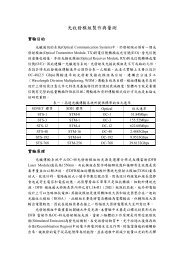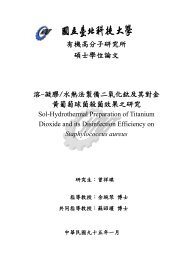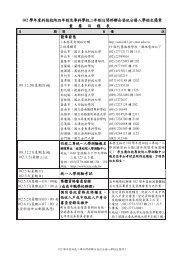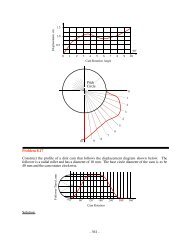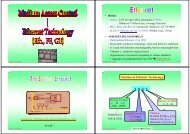Object-Oriented Programming Visitor Pattern Observer Pattern
Object-Oriented Programming Visitor Pattern Observer Pattern
Object-Oriented Programming Visitor Pattern Observer Pattern
Create successful ePaper yourself
Turn your PDF publications into a flip-book with our unique Google optimized e-Paper software.
<strong>Object</strong>-<strong>Oriented</strong> <strong>Oriented</strong> <strong>Programming</strong><strong>Visitor</strong> <strong>Pattern</strong><strong>Observer</strong> <strong>Pattern</strong>CSIE Department, NTUTWoei-Kae Chen
<strong>Visitor</strong> <strong>Pattern</strong><strong>Visitor</strong> <strong>Pattern</strong>Behavioral pattern
<strong>Visitor</strong>: Intent•Represent an operation to be performed onthe elements of an object structure.– <strong>Visitor</strong> lets you define a new operation withoutchanging the classes of the elements on which itoperates.•Example 1object structure: abstract syntax tree of a compilerelement: AssignmentNode, etc.operations: GenerateCode, etc.•Example 2object structure: Petri Netelement: place, transition, etc.operations: fire, etc.•Example 3object structure: logic circuitselement: i/o pins, AND, OR, NOT, IC, etc.operations: simulate, etc.
<strong>Visitor</strong>: Motivation (1)• Option 1: implement operations on each ConcreteNode class– distributing operations across node classes hard to understand, maintain,and change– confusing to have type-checking code mixed with pretty-printing code.– adding a new operation requires recompiling all of these classesobject structure•list of elements•compositesElementNodeTypeCheck()GenerateCode()PrettyPrint()operations onabstract syntax treeVariableRefNodeTypeCheck()GenerateCode()PrettyPrint()AssignmentNodeTypeCheck()GenerateCode()PrettyPrint()
<strong>Visitor</strong>: Motivation (2)• Option 2: <strong>Visitor</strong> pattern– Use a Node<strong>Visitor</strong> hierarchy to define operations on the elements– Fixed grammar fixed Node classes easy to add new functionality (visitor)Performoperations onconcrete classNode<strong>Visitor</strong>VisitAssignment(AssignmentNode)VisitVariableRef(VariableRefNode)Integrating all codegeneration programsinto one classTypeChecking<strong>Visitor</strong>VisitAssignment(AssignmentNode)VisitVariableRef(VariableRefNode)CodeGeneration<strong>Visitor</strong>VisitAssignment(AssignmentNode)VisitVariableRef(VariableRefNode)GenerateCode()removedProgramMust openinterfaces fordifferent <strong>Visitor</strong>sAssignmentNodeAccept(Node<strong>Visitor</strong> v)v->VisitAssignment(this)NodeAccept(Node<strong>Visitor</strong>)VariableRefNodeAccept(Node<strong>Visitor</strong> v)v->VisitVariableRef(this)GenerateCode()moved here
<strong>Visitor</strong>: Applicability• Use the <strong>Visitor</strong> pattern when– an object structure contains many classes of objectswith differing interfaces, and you want to performoperations on these objects that depend on theirconcrete classes.– avoid “polluting” classes with many distinct andunrelated operations• visitor lets you keep related operations together by definingthem in one class– the object classes rarely change, but you often want todefine new operations over the structure• changing object classes often better to define operations inobject classes
<strong>Visitor</strong>: StructureClient<strong>Visitor</strong>VisitConcreteElementA(ConcreteElementA)VisitConcreteElementB(ConcreteElementB)Concrete<strong>Visitor</strong>1VisitConcreteElementA(ConcreteElementA)VisitConcreteElementB(ConcreteElementB)Concrete<strong>Visitor</strong>2VisitConcreteElementA(ConcreteElementA)VisitConcreteElementB(ConcreteElementB)<strong>Object</strong>StructureElementAccept(<strong>Visitor</strong>)<strong>Visitor</strong> as anargumentMay be aComposite patternConcreteElementAAccept(<strong>Visitor</strong> v)OperationA()ConcreteElementBAccept(<strong>Visitor</strong> v)OperationB()v->VisitConcreteElementA(this)v->VisitConcreteElementB(this)
<strong>Visitor</strong>: Participants• <strong>Visitor</strong> (Node<strong>Visitor</strong>)– declares a VisitConcreteElement operation for eachConcreteElement class in the object structure.• Concrete<strong>Visitor</strong> (CodeGeneration<strong>Visitor</strong>, etc.)– defines an operation to the object structure.– implements each operation declared by <strong>Visitor</strong>.– may accumulate results during the traversal of the object structure.• Element (Node)– defines an Accept operation that takes a visitor as argument.• ConcreteElement (AssignmentNode, etc.)– implements an Accept operation that takes a visitor as anargument.• <strong>Object</strong> structure (Program)– can enumerate its elements.– may provide a high-level interface to allow the visitor to visit itselements.– may either be a composite or a collection such as a list or a set.
<strong>Visitor</strong>: Collaboration• A client creates a Concrete<strong>Visitor</strong> object, then– traverse the object structure, visiting each element with the visitor.• When an element is visited (accepts a visitor)– it calls the visitor operation that corresponds to its class.– passing itself as an argument if necessary.an<strong>Object</strong>Structure aConcreteElementA aConcreteElementB aConcrete<strong>Visitor</strong>Accept(a<strong>Visitor</strong>)VisitConcreteElementA(aConcreteElementA)OperationA( )Accept(a<strong>Visitor</strong>)VisitConcreteElementB(aConcreteElementB)OperationB( )
<strong>Visitor</strong>: Consequences (1)• Benefits– <strong>Visitor</strong> makes adding new operations easy• simply add a new concrete visitor.• in contrast, if you spread functionality over many classes, thenyou must change each class to define a new operation.– A visitor gathers related operations and separatesunrelated ones• related behavior is localized in a visitor.– Accumulating state• <strong>Visitor</strong>s are arguments <strong>Visitor</strong>s can accumulate state as theyvisit each element in the object structure.– The Collecting Parameter pattern.• Without a <strong>Visitor</strong> pass state as extra arguments to theoperations that perform the traversal.
<strong>Visitor</strong>: Consequences (2)• Benefits– Visiting across class hierarchies• An iterator can also visit the objects in a structure.• Iterator all elements must have a common parent class (Item)template class Iterator {...Item CurrentItem() const;};• <strong>Visitor</strong> can visit objects that do not have a common parent classclass <strong>Visitor</strong> {public:...void VisitMyType(MyType *);void VisitYourType(YourType *);};
<strong>Visitor</strong>: Consequences (3)• Liabilities– Adding new ConcreteElement classes is hard• a new ConcreteElement a new abstract operation on <strong>Visitor</strong> change every Concrete<strong>Visitor</strong> Class.– Breaking encapsulation• The ConcreteElement’s public interface must be powerfulenough to let visitors do their job often forces you toprovide public operations that access an element’s internalstate.
<strong>Visitor</strong>: Implementation (1)• The <strong>Visitor</strong> class (C++)class <strong>Visitor</strong> {public:virtual void VisitElementA(ElementA *);virtual void VisitElementB(ElementB *);...protected:<strong>Visitor</strong>(); // protected constructor};• The Concrete<strong>Visitor</strong> class (C++)class Concrete<strong>Visitor</strong>1 : public <strong>Visitor</strong> {public:Concrete<strong>Visitor</strong>1();virtual void VisitElementA(ElementA *e){...; e->OperaionA(); ...;}virtual void VisitElementB(ElementB *e);{...; e->OperaionB(); ...;}};Concrete operationConcrete Element
<strong>Visitor</strong>: Implementation (2)• The Element class (C++)class Element {public:virtual ~Element();virtual void Accept(<strong>Visitor</strong> &) = 0;protected:Element(); // protected constructor};• The ConcreteElement class (C++)class ElementA : public Element {public:ElementA();virtual void Accept(<strong>Visitor</strong> &v){v.VisitElementA(this);}};class ElementB : public Element {public:ElementB();virtual void Accept(<strong>Visitor</strong> &v){v.VisitElementB(this);}};double dispatchaccumulatingstates
<strong>Visitor</strong>: Implementation (3)• A CompositeElement class (C++)class CompositeElement : public Element {public:CompositeElement();virtual void Accept(<strong>Visitor</strong> &) {ListIterator i(_children);for (i.First(); !i.IsDone(); i.Next()) {i.CurrentElement()->Accept(v);}v.VisitCompositeElement(this);}private:List *_children;};Compositepattern
<strong>Visitor</strong>: Implementation (4)• Implementation issues– Double dispatch• Single dispatch– The operation that gets executed depends both on the kind ofrequest and the type of the (one) receiver.– C++ supports only single-dispatch.• Double (multiple) dispatch– The operation that gets executed depends on the kind ofrequest and the types of two receivers.– Languages that support multiple-dispatch lessen the need forthe <strong>Visitor</strong> pattern.• Accept is a double-dispatch operation– Its meaning depends on two types: the <strong>Visitor</strong>’s and theElement’s.– Accept do the binding at run-time.
<strong>Visitor</strong>: Implementation (5)• Implementation issues– Who is responsible for traversing the object structure?(1) In the object structure– A collection simply iterate over its elements, calling theAccept operation on each.– A Composite implements the Accept operation by calling itschildren’s Accept operation recursively.(2) Using a separate iterator object– Iterators can be used to traverse the object structure.– The key to the <strong>Visitor</strong> pattern is double-dispatching: theoperation that gets executed depends on both the type of <strong>Visitor</strong>and the type of Element it visits.(3) In the <strong>Visitor</strong>– When implementing complex traversal that depends on theresults of the operations on the object structure.– Usually end up duplicating the traversal code in eachConcrete<strong>Visitor</strong> for each aggregate ConcreteElement.
<strong>Visitor</strong>: Related <strong>Pattern</strong>s•Composite pattern– <strong>Visitor</strong>s can be used to apply an operation overan object structure defined by the Compositepattern.•Interpreter pattern– <strong>Visitor</strong> can be applied to do the interpretation.
<strong>Observer</strong> <strong>Pattern</strong><strong>Observer</strong> <strong>Pattern</strong>Behavioral pattern
<strong>Observer</strong>: Intent•Define a one-to-many dependency betweenobjects so that when one object changesstate, all its dependents are notified andupdated automatically.•Also known as– Dependents– Publish-Subscribe
<strong>Observer</strong>: Motivation• <strong>Observer</strong> pattern– describes how to establish the relationship between subject (one)and observers (many).xyza b c605080303010102010a b cabc<strong>Observer</strong><strong>Observer</strong>Subjecta = 50%b = 30%c = 20%change notificationrequests, moifications
<strong>Observer</strong>: Applicability• Use the <strong>Observer</strong> pattern in any of the followingsituations– When an abstraction has two aspects, one (object)dependent on the other (object).• Encapsulating these aspects in separate objects lets you varyand reuse them independently.– When a change to one object requires changing others,and you do not know how many objects need to bechanged.– When an object should be able to notify other objectswithout knowing who these objects are.• objects are loosely coupled
<strong>Observer</strong>: StructureSubjectAttach(<strong>Observer</strong>)Detach(<strong>Observer</strong>)Notify()observersfor all o in observerso->Update();<strong>Observer</strong>Update()ConcreteSubjectGetState()SetState()subjectStatesubjectConcrete<strong>Observer</strong>Update()observerStatereturn subjectStateCall Notify()?observerState =subject->GetState()
<strong>Observer</strong>: Participants• Subject– knows its observers. Any number of <strong>Observer</strong> objects mayobserve a subject.• <strong>Observer</strong>– defines an updating interface for objects that should be notified ofchanges in a subject.• ConcreteSubject– stores state of interest to Concrete<strong>Observer</strong> objects.– sends a notification to its observers when its state changes.• Concrete<strong>Observer</strong>– maintains a reference to a ConcreteSubject object.– stores state that should stay consistent with the subject’s.– implements the <strong>Observer</strong> updating interface to keep its stateconsistent with the subject’s.
<strong>Observer</strong>: Collaborations• A ConcreteSubject notifies its observers whenever a change occurs.• A Concrete<strong>Observer</strong> query the subject for information to reconcile itsstate.aConcreteSubject aConcrete<strong>Observer</strong> anotherConcrete<strong>Observer</strong>SetState()Notify()Update()GetState()Update()GetState()
<strong>Observer</strong>: Consequences• Benefits– Vary subjects and observers independently.– Add observers without modifying the subject orother observers.– Abstract coupling between Subject and <strong>Observer</strong>• The subject does not know the concrete class of any observer.– Support for broadcast communication• The notification is broadcast automatically to all interestedobjects that subscribed to it.• Liabilities– Unexpected updates• A seemingly harmless operation on the subject may cause acascade of updates to observers and their dependent objects.
<strong>Observer</strong>: Implementation (1)• Mapping subjects to their observers– store references in the subject• such storage may be too expensive when there are many subjects andfew observers.– associative lookup• maintains subject-to-observer mapping.• increases the cost of accessing observers.• Observing more than one subject– extend the Update interface to let the observer know whichsubject is sending the notification.– the subject may pass itself as a parameter in the Update operation.• Dangling references to deleted subjects– deleting the observers is not an option because other objects mayreference them.– make the subject notify its observers as it is deleted so that theycan reset their reference to it.
<strong>Observer</strong>: Implementation (2)• Who triggers the update? (calls notify)– SetState call Notify after its state is changed• Advantage: client do not have to remember to call Notify• Disadvantage: several consecutive operations will cause severalconsecutive updates inefficient.– Client calls Notify at the right time• Advantage: client can trigger an update after a series of state changes more efficient.• Disadvantage: client might forget to call notify error prone.• Making sure Subject state is self-consistent beforenotification– Use Template Method• define a primitive operation for for subclasses to override and makeNotify the last operation in the Template Method.void Text::Cut(TextRange r) { // Template MethoddoReplaceRange(r); // redefined in subclassesNotify();}
<strong>Observer</strong>: Implementation (3)• Avoiding observer-specific update protocols: the push andpull models– The subject may pass change information as an argument toUpdate– Push model• The subject sends observers detailed information about the change,whether they want it or not.• The subject knows something about <strong>Observer</strong> classes– Pull model• The subject sends nothing, and observers ask for details.• <strong>Observer</strong> must ascertain what changed without help from the Subject inefficient.• Specifying modification of interest explicitly– Improve update efficiency by extending the subject’s interface toallow registering observers only for specific events of interest.void Subject::Attach(<strong>Observer</strong>*, Aspect &interest);void <strong>Observer</strong>::Update(Subject*, Aspect &interest);
<strong>Observer</strong>: Implementation (4)• Encapsulating complex update semantics– Use a ChangeManager object (a Mediator) to minimize the workrequired to make observers reflect a change (eliminatingunnecessary updates).SubjectAttach(<strong>Observer</strong> o)Detach(<strong>Observer</strong>)Notify()subjects ChangeManagerRegister(Subject,<strong>Observer</strong>)Chman UnRegister(Subject,<strong>Observer</strong>)Notify()observers<strong>Observer</strong>Update(Subject)chman->Notify()chman->Register(this,o)SimpleChangeManagerRegister(Subject,<strong>Observer</strong>)UnRegister(Subject,<strong>Observer</strong>)Notify()DAGChangeManagerRegister(Subject,<strong>Observer</strong>)UnRegister(Subject,<strong>Observer</strong>)Notify()for all s in subjectsfor all o in s.observerso->Update(s)mark all observers to updateupdate all marked observers
<strong>Observer</strong>: Implementation (5)• Combining the Subject and <strong>Observer</strong> classes– Combine the interface of Subject and <strong>Observer</strong> in oneclass for an object to act as both a subject and aobserver.– When multiple inheritance is not supported (e.g.,Smalltalk).
<strong>Observer</strong>: Related <strong>Pattern</strong>s•Mediator– By encapsulating complex update semantics,the ChangeManager acts as mediator betweensubjects and observers.•Singleton– The ChangeManager may use the Singletonpattern to make it unique and globallyaccessible.



